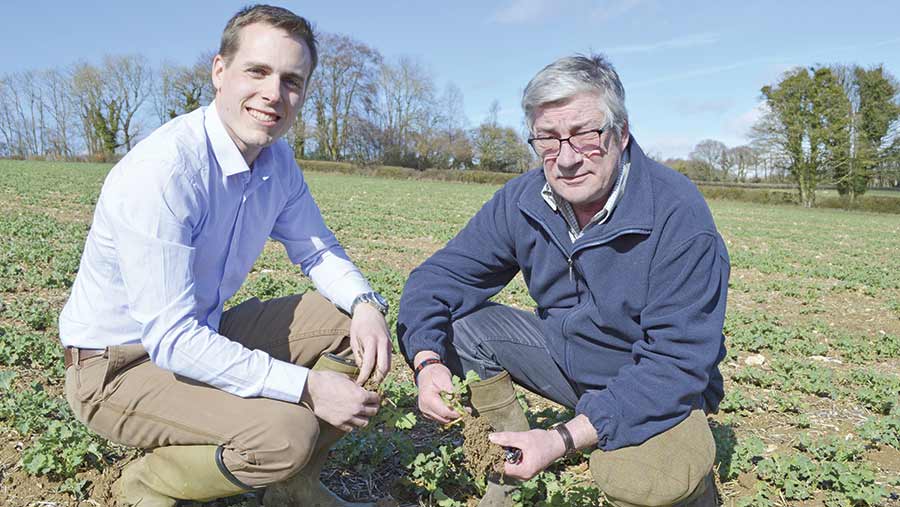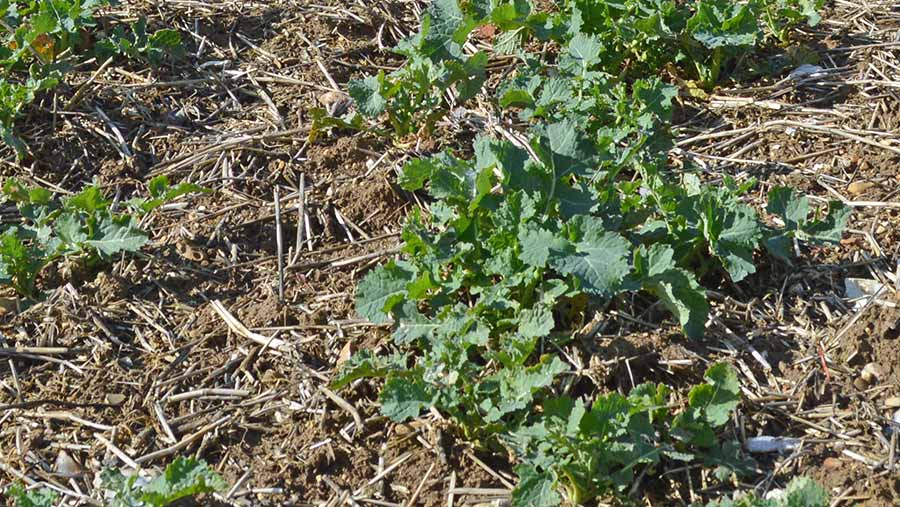Oilseed rape variety proves its worth in charlock-infested field
 Independent agronomist Ben Burrows (left) and grower Michael Maxwell © David Jones/RBI
Independent agronomist Ben Burrows (left) and grower Michael Maxwell © David Jones/RBI Michael Maxwell vowed never to grow oilseed rape again on a charlock-infested field until being tempted to try a variety tolerant to a herbicide particularly good at killing this brassica weed.
The Hampshire farm manager had struggled to get a rapeseed crop established in the wet autumn of 2012 on this field, and come harvest the following year the crop was virtually impossible to combine due to severe weeds.
“We are never growing oilseed rape in that field again,” he said, after his combine driver asked him if he really wanted to cut the crop.
See also: Tips for raising oilseed rape yields
Five years on and oilseed rape was due to be planted in the field as part of the farm’s rotation, and he only decided to try again with a crop in which he could control charlock.
The plan started badly as the previous winter barley crop was severely lodged so difficult to combine and there was real difficult in incorporating the crop residue.

© David Jones/RBI
Late drilling
The drill only went into the field a month later than ideal on 15 September, but an open autumn and a lack of pigeons helped the crop off to a promising start, and he was surprised how well the crop looked in mid-March.
“Oilseed rape is an important part of our rotation, so it was a ideal opportunity to try something new,” he tells Farmers Weekly.
The leading Clearfield variety Imperial from Monsanto was drilled on the 27ha field. These varieties are bred conventionally with tolerance to the herbicide imazamox, which has good activity against brassica weeds such as charlock and runch.
Independent agronomist Ben Burrows was keen to target this problem field on the 800ha farm Mr Maxwell manages at Preston Farms, Preston Candover, just six miles south of Basingstoke, and he chose a Clearfield variety for four reasons.
- Ease of brassica weed control “This is the main reason, and is especially important where severe charlock and runch would make oilseed rape unviable,” he says.
- Wait and see before spending on herbicides, as in most cases no pre-emergence herbicide is needed “So we can see how the crop establishes before spending serious money on post emergence herbicides,” he adds.
- Flexible herbicide programmes It is possible to sequence with other post-emergence herbicides depending on the weed pressure.
- Opportunities for companion cropping A companion crop such as white mustard can be established to help with cabbage stem flea beetle control, then be killed off with post-emergence herbicide.
Agrochemical company BASF produces two herbicide mixes for use on Clearfield varieties – Cleranda (imazamox + metazachlor) and Cleravo (imazamox + quinmerac).
The group’s oilseed rape specialist Clare Tucker says the two products should allow grower to miss out on a pre-emergence, and so they can assess crops before spraying with these post-emergence products.
“The products have the widest weed control spectrum of any oilseed rape herbicides,” she says.
Rising market share
Clearfield varieties could take a 15%-plus share of the oilseed rape market this autumn following on from strong gains in the East, South East and West Midlands of England this season.
Mark Shaw, Monsanto’s marketing manager, says the varieties account for 10% of the 600,000ha of oilseed rape in ground at the moment, or some 61,000ha.
“We are looking for 100,000ha next season and believe a market share of 15% plus is very achievable,” he says.
Mr Shaw believes the overall area UK oilseed rape area could rise 5% to 630,000ha next season with Clearfield varieties taking a 15.8% share if they are drilled across 100,000ha.
This would be the second year of overall growth in the oilseed rape area after this season 5% rise came after five years of declines from harvest 2012 at 715,000ha.
Monsanto markets the two most popular Clearfield varieties, Imperial and Impression.

